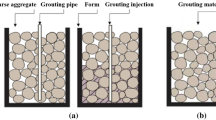Abstract
The quality of concrete is extremely important for the construction and mining sectors. One of the most important factors determining the quality of concrete depends on aggregates, which are not always homogeneous. On the other hand, there is an obligation to use aggregates obtained from different quarries. In such cases, the aggregates having different properties must be blended in order to maintain the desired concrete quality. In this study, optimization was performed using a linear programming in order to blend the aggregates at different qualities. Meanwhile, the objective function was determined to minimize the cost of aggregate production on the model. The limit values in the literature and national standards for the usability of aggregates in concrete were defined as constraints in the linear optimization and evaluated with the objective functions. Therefore, the most suitable aggregate blends were composed in order to obtain the requested concrete quality. As a conclusion, the most appropriate product blends were obtained in the research fields, and the usability of this model for those quarries was evaluated to provide the sustainability of product quality.



Similar content being viewed by others
References
Adiguzel D (2012) Determination of optimal aggregate blending with linear programming in concrete production. Istanbul University, PhD Thesis
Adiguzel D, Bascetin A, Yilmaz M, Tugrul A, Tuylu S (2011) Determination of optimal aggregate blending policy with linear programming in a quarry. In: Proceedings of the twentieth international symposium on mine planning and equipment selection MPES 2011, Almaty, Republic of Kazakhstan, Oct 12–14
Alexander MG, Mindness S (2005) Aggregates in concrete (Modern Concrete Technology). Taylor & Francis Group, London, New York, p 448
Al-Tabtabai H, Alex A (1999) Using genetic algorithms to solve optimization problems in construction. Eng Constr Archit Manag. doi:10.1108/eb021105
Ashayeri J, Eijs AGM, Nederstigt P (1994) Blending modeling in a process manufacturing: a case study. Eur J Oper Res 72:460–468
Bascetin A, Adiguzel D (2011) Determination of optimal aggregate blending with linear programming in a quarry. In: Proceedings of the Beton 2011 congress, Oct 20–22, Istanbul
Bascetin A, Adiguzel D, Tuylu S (2011) Investigation of CO2 emissions based on energy consumption in the production of aggregate. In: 22nd World mining congress & expo, 11–16 Sept, Istanbul
Charnes A, Cooper WW, Mellon B (1952) Blending aviation gasolines—a study in programming interdependent activities in an integrated oil company. Econometrica 20(2):135–159
Chaovalitwongse W, Furman KC, Pardalos PM (2009) Optimization and logistic challenges in the enterprise, vol 30. Springer, New York, p 431
Dantzig GB (1963) Linear programming and extensions. Princeton University Press, Princeton
Durmus A, Dogangun A, Yayli A (1988) The effect of sand pollution on mechanical behaviours of concrete. Turkish Precast Concrete Association, No: 8, Ankara
Dutta G, Fourer R (2001) A survey of mathematical programming applications in integrated steel plants. Manuf Serv Oper Manag Informs 3(4):387–400
Easa SM, Asce M, Can EK, Asce AM (1985a) Stochastic priority model for aggregate blending. J Constr Eng Manag 3(4):358–373
Easa SM, Asce M, Can EK, Asce AM (1985b) Optimization model for aggregate blending. J Constr Eng Manag 3(3):216–229
Kikuchi S, Kronprasert N, Easa S (2012) Aggregate blending using fuzzy optimization. J Constr Eng Manag. doi:10.1061/(ASCE)CO.1943-7862.0000557
Kock HCD, Sinclair M (1987) Multi-mix feedstock problems on microcomputers. J Oper Res Soc 38(7):585–590
Kumral M (2003) Application of chance-constrained programming based on multi objective simulated annealing to solve a mineral blending problem. Eng Optim 35(6):661–673
Lee SM, Olson DL (1983) Chance constrained aggregate blending. J Constr Eng Manag 109(1):39–47
Montemanni R, Toklu N, Toklu S, Toklu Y (2011) Aggregate blending via robust linear programming. J Constr Eng Manag. doi:10.1061/(ASCE)CO.1943-7862.0000422
Persson L (2002) Rock materials for construction: resources, properties, heterogeneity and suitability for use: examples and issues from the precambrian of Sweden. In: Proceedings of 9th IAEG congress, Durban, South Africa, pp 105–120
Prabhakar T (1968) A generalized linear programming solution to separation-blending problems. Ind Eng Chen Fundam 7(4):626–632
Raissanen M, Torppa A (2005) Quality assessment of a geologically heterogeneous rock quarry in Pirkanmaa County, Southern Finland. Bull Eng Geol Environ 64:409–418. doi:10.1007/s10064-005-0006-1
Sakalli US (2010) The modelling and solution approaches based on possibility and probability theory for blending problems in casting industry. Gazi University, PhD, Ankara
Sarker RA, Newton CS (2008) Optimization modelling. CRC press, Taylor & Francis Group, Boca Raton, London, New York, p 469
Shammari MA, Dawood I (1997) Linear programming applied to a production blending problem a spreadsheet modelling approach. Prod Invent Manag J 38:1
Stigler GJ (1945) The cost of subsistence. J Farm Econ 27(2):303–314
Toklu YC (2005) Aggregate blending using genetic algorithms. Comput Aided Civ Infrastruct Eng 20:450–460
Wilson E, Willis R (1985) Microcomputers and linear programming-feedstock revisited. Eur J Oper Res 19:297–304
Yeh IC (1999) Design of high performance concrete mixture using neural networks and nonlinear programming. J Comput Civ Eng 13(1):36–42
Acknowledgments
This study was supported by Istanbul University Scientific Research Projects (Project Numbers: 42257, T8787, 40376 and 38743). The authors would like to thank to Istanbul University and Responsible and workers of the quarry.
Author information
Authors and Affiliations
Corresponding author
Rights and permissions
About this article
Cite this article
Atac, B., Deniz, A., Serkan, T. et al. Study of the optimal aggregate blending model for quarries. Environ Earth Sci 75, 1304 (2016). https://doi.org/10.1007/s12665-016-6126-z
Received:
Accepted:
Published:
DOI: https://doi.org/10.1007/s12665-016-6126-z




